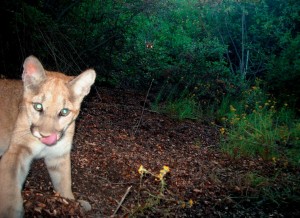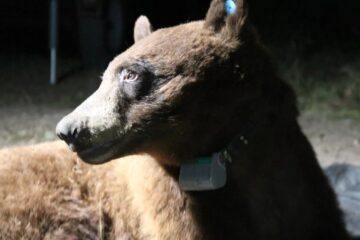Cause of young female mountain lion’s death still unknown
Carcass found in Sycamore Canyon being studied in lab
Source of this article: The Thousand Oaks Acorn, November 1, 2012
Scientists are still trying to figure out what killed a 1-year-old female mountain lion found last week in the upper portion of Sycamore Canyon.

JUST A KITTEN—A remote camera captured this photograph of a mountain lion, known as P-25, earlier this year. The female cat was found dead last week by hikers in the upper portion of Sycamore Canyon near Newbury Park. Courtesy of National Park Service
The animal’s cause of death will likely be determined sometime in the next month, according to Seth Riley, a representative for the Santa Monica Mountains National Recreation Area.
The carcass, identified as Puma 25 and discovered by a group of hikers on Oct. 21, is being tested at a branch of the California Animal Health and Food Safety Lab in San Bernardino, Riley said.
A recent graduate of California State University Channel Islands, biology major Jackie Lockhart was hiking with her two roommates on the canyon’s Waterfall Trail when they smelled something peculiar.
“It smelled funky,” Lockhart said. “We went looking around and saw (the carcass) in this deep crevice, not far off the trail.”
“It looked like nature had run its course,” Lockhart added. “Most of her body was intact (but) her rear end looked like it had been rotting away.”
A frequent hiker, the 23-yearold Port Hueneme resident said she was taken aback by the sight.
“I thought, ‘wow,’” she said. “No one ever sees mountain lions.”
Admittedly “pretty sad” about the kitten’s death, Lockhart contacted CSUCI professor Sean Anderson, who studies the animals.
“It looked kind of important,” she said.
The animal, which showed no outward signs of before-death trauma, was part of a decade-long study conducted by biologists from the Santa Monica recreation area, a unit of the National Park Service.
In the last 10 years, the unit has tracked a total of 26 mountain lions to better understand their survival in an urbanized landscape.
In that time, the organization has closely monitored changes in the cats’ population.
In 2011, a 15-month-old male was killed by a car on the 405 Freeway near the Getty Center.
Two weeks later, a 7-year-old female was found dead and mutilated on the side of the road.
Experts believe the cougar was the victim of illegal poaching.
In August, two newborn kittens were found—the second documented case of first-order inbreeding, in which a father lion mates with his offspring.
“It’s our job to do our best to preserve all the animals in the ecosystem,” Riley said. “We try to gather as much information as possible.”
A few months before her death, Puma 25 had been fitted with an expandable tracking collar, meant to adjust to her growing size.
“She got hers off after about three weeks,” Riley said. “We were able to identify her by her ear tags.”
Although the circumstances of the kitten’s death remain unknown, she may have died from an exposure to anticoagulant poisons, which prevent the clotting of the blood. In 2004, two local mountain lions died after ingesting the poisons, which are typically used to kill rodents.
“If they get a cut, they usually bleed internally (and) they eventually die,” Riley said.
According to a study done by the Park Service, in addition to poisoning, mountain lions often die from vehicle collisions and conflicts with other mountain lions.
Riley said connecting plots of habitat are key to the survival of mountain lions in the Santa Monica Mountains.
“When animals die, new ones need to be able to come in,” he said. “There needs to be a connection between the areas so they can breed.”
Because the 101 Freeway and other large roadways divide the species’ habitat, mountain lion populations in the local mountain range are endangered.
The park service hopes to build an underpass below the freeway.
“We’re hoping we can maintain enough connectivity between the 101 and other freeways so we don’t have to move the animals ourselves,” Riley said.
An advocate for wildlife preservation, Riley said he did not know how dwindling mountain lion populations might affect the remaining ecosystem.
“It’s really not an experiment we want to conduct,” he said.


